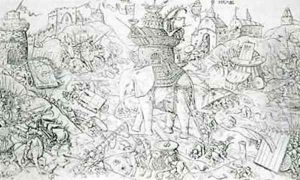Alart du Hameel Paintings
Alart du Hameel, also known as Alardus de Hameel or Alart de Hamel, was a Northern Renaissance artist, primarily known for his work as a manuscript illuminator. He was born around the year 1440, though the exact date and place of his birth remain uncertain. Du Hameel was active during a period of significant artistic development in Europe, which was marked by the transition from medieval to Renaissance styles.
Du Hameel's career is primarily documented through his work on illuminated manuscripts, and he was known for his intricate and detailed miniature paintings. His style combined Gothic and early Renaissance elements, reflecting the transitional nature of art during his lifetime. He was particularly noted for his skill in depicting narrative scenes, often filled with rich colours and elaborate decorative patterns. The figures in his miniatures display a sense of volume and three-dimensionality that was characteristic of the emerging Renaissance style.
There is not much known about Alart du Hameel's personal life or training. However, it is believed that he worked in 's-Hertogenbosch (present-day Netherlands), as several documents and commissions are associated with this city. He was active at a time when 's-Hertogenbosch was an important cultural and artistic center, which was also the hometown of Hieronymus Bosch, another renowned artist of the period.
One of his most significant contributions was his work for the Brotherhood of Our Lady, a religious confraternity in 's-Hertogenbosch. Du Hameel was commissioned by them to create illuminated manuscripts and other works of art. His connection with this brotherhood suggests that he was a respected member of the local art community and that his work was in high demand.
Alart du Hameel passed away in 1509. While he may not be as widely recognized as some of his contemporaries, his work provides valuable insight into the artistic transition that occurred during his lifetime and contributes to our understanding of Northern Renaissance art. His legacy is preserved in the manuscripts and miniatures he left behind, which continue to be studied and admired for their beauty and historical significance.
